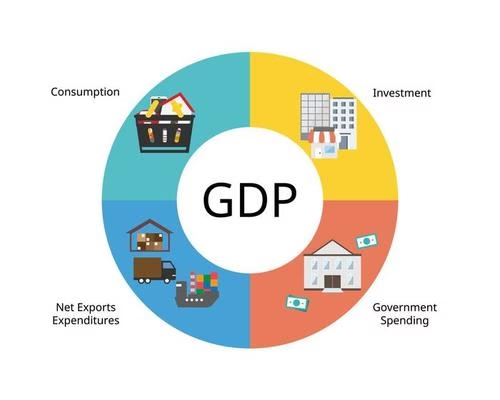It is the sum of the value of all final goods and services produced in a country in a financial year or accounting year.
Note: The financial year in India begins on 1st April and ends with 31st March, commonly referred as FY.
Three ways of measuring GDP
GDP is the sum of the market value of all the final goods and services produced within the geographical boundaries of a country each year. The value of GDP measured in current prices is called Nominal GDP but it might not be a good measure of production because the increase in value may result from an increase in prices and not output. Nominal GDP, adjusted for price changes, is called Real GDP.
Nominal GDP per capita = Nominal GDP/total population
Real GDP per capita = Real GDP/total population
Furthermore, economists rely on three approaches to accurately measure GDP: Expenditure, Income, and Product. GDP calculated from all these approaches should give the same value. However, GDP measurement also depends on the structure of the economy. In a four-sector open economy, economic activities involve interactions among four key sectors:
1. The consumers
2. The producers
3. The government sector
4. The rest of the world sector (ROW)
Each sector has a significant role in determining GDP, and their combined contributions are reflected in the three GDP measurement approaches.
Expenditure approach
The expenditure approach is a sum of four key components – personal consumption expenditure (C), investment expenditure (I), government expenditure (G), and net exports (X-M) by the ROW sector.
Government purchases are calculated both at the federal level and state and local levels and consist of both defense and non-defense expenditures. Net exports are calculated as the value of exports to the ROW minus the value of imports from the ROW. Thus, this approach captures the total spending within an economy.
Income approach
The income approach is very simply calculated as income earned from all sources and includes wages and salaries, proprietors’ income (earnings from self-employment and unincorporated businesses), rental income, corporate profits, and net interest earned (interest earned minus interest paid). Additionally, the concept of GDP also includes net indirect taxes, statistical discrepancy, depreciation, and net payments made to the ROW.
Product approach
The product approach, also known as the output method or value-added method, adds up the market value of all goods and services produced, excluding the goods used in the intermediate stages of production.
The three GDP measurement approaches must always give the same total due to the following relationships:
Equivalence of production and expenditure: The market value of goods and services produced in each period is, by definition, equal to the amount that buyers must spend to purchase them.
Thus, Value of Product Approach = Total obtained by Expenditure approach (Equation 1).
Equivalence of expenditure and income: What sellers receive must be equal to what buyers spend. In other words, sellers’ receipts represent the income generated from economic activity, including income paid to workers and suppliers, and taxes paid to the government, and profits.
Therefore, Total Expenditure = Total Income (Equation 2)
Because of (1) and (2) , Total product = Total income
The Total Product = Total Income = Total Expenditure is called the fundamental identity of national income accounting.
Formula to compute GDP:
Y = C + I + G + X – M
Y = GDP (or) Total Output
C = Consumption Expenditure of the Households
I = Investment Expenditure
G = Government Expenditure
X = Exports
M = Imports
(or)
Y= PFCE + GFCE + GCF + NX
PFCE = Private Final Consumption Expenditure
GFCE = Government Final Consumption Expenditure
GCF = Gross Fixed Capital Formation
NX = Net Exports(X-M)
- If Exports are more than imports, that is NX is positive, then the nation is said to have trade surplus.
- If Exports are less than imports, that is NX is negative, then the nation is said to have trade deficit.
- If Exports are equal to imports, that is NX is zero, then the nation is said to have balanced trade.
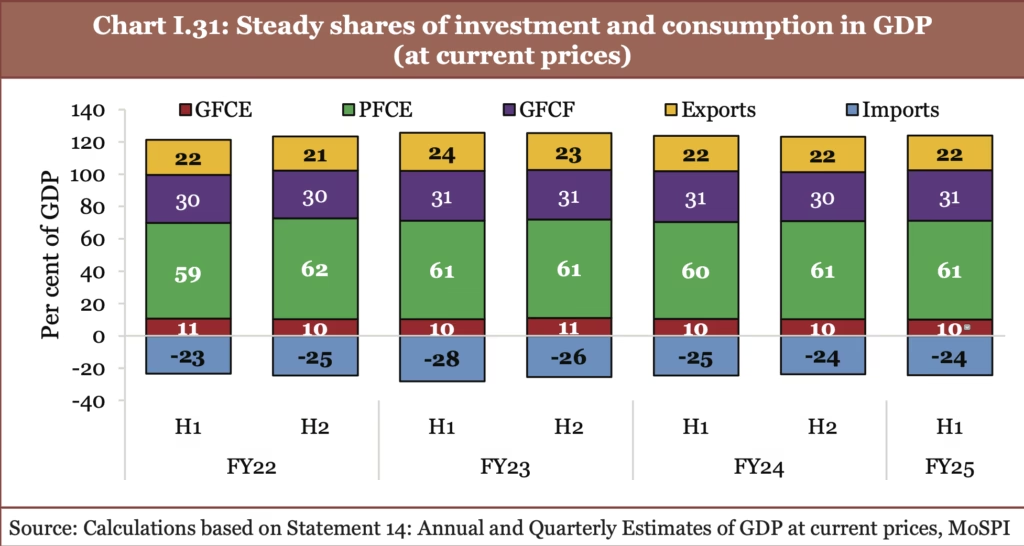
GDP calculation: Factor cost vs. market price approaches
India’s GDP is estimated by the Central Statistical Office (CSO) using two methods. One is based on economic activity (at factor cost, this does not include taxes), and the second is on expenditure (at market prices, this includes taxes).
Economic activity-based method (at factor cost): This measures GDP based on the cost of production, excluding taxes but including subsidies.
Expenditure-based method (at market prices): This calculates GDP based on total spending in the economy, including taxes but excluding subsidies.
Sectors using factor cost method
The factor cost method is calculated by collecting data for each sector during a particular time-period. Due to the lack of reliable data for the other two methods, GDP is primarily measured using the factor cost method across the following sectors:
1. Agriculture, forestry, and fishing
2. Mining and quarrying
3. Manufacturing
4. Electricity, gas, water supply, and other utility services
5. Construction
6. Trade, hotels, transport, communication, and broadcasting
7. Financial, real estate, and professional services
8. Public administration, defense, and other services.
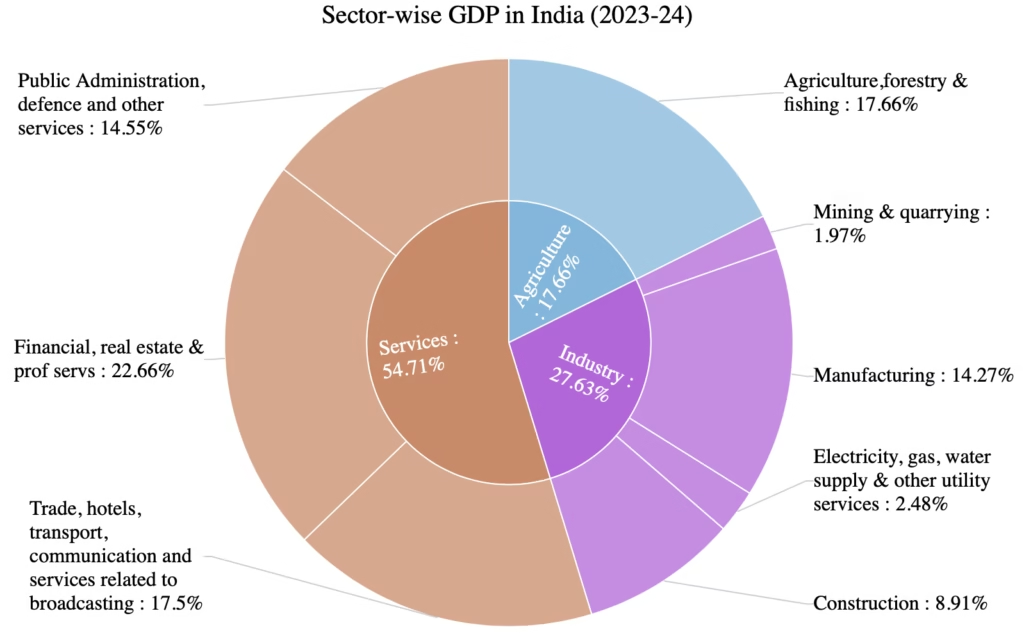
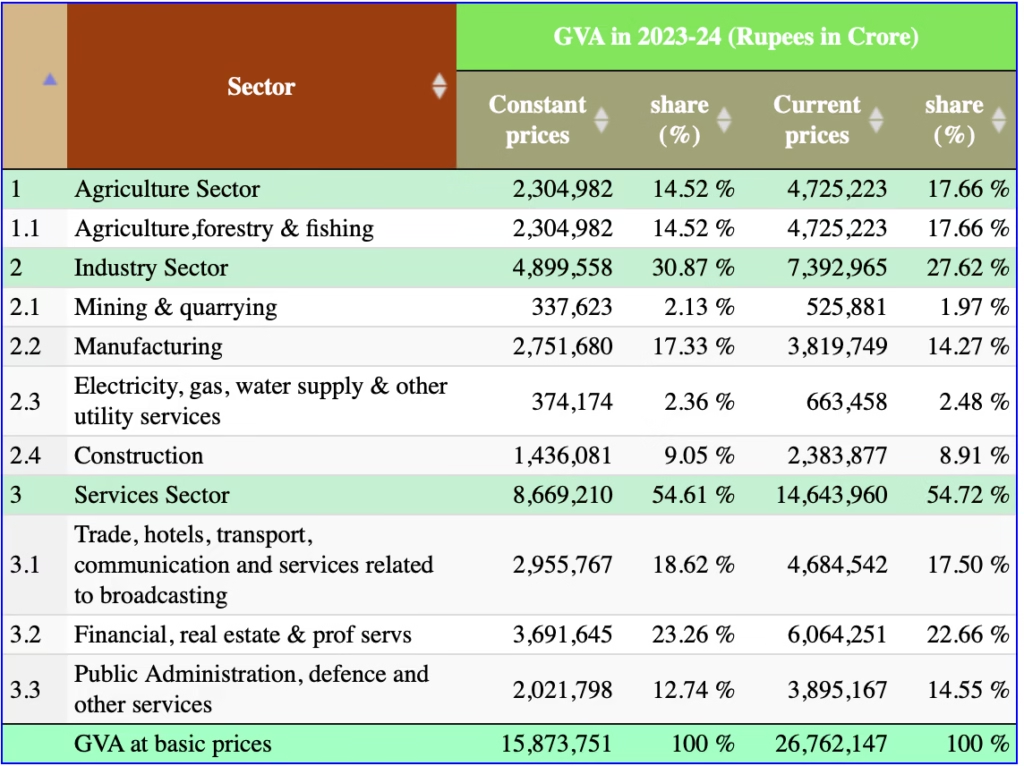
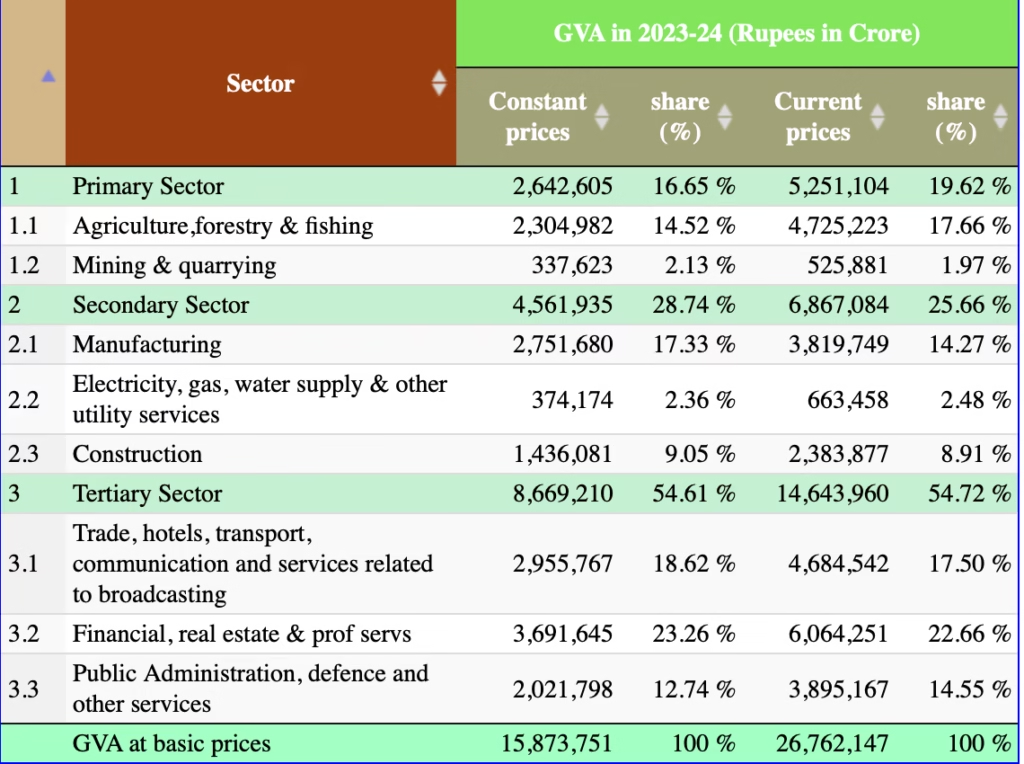
Sectors using expenditure method
The expenditure method involves summing the domestic expenditure on final goods and services across various streams during a particular time-period. It includes consideration of expenses towards household consumption, net investments (capital formation), government costs, and net trade (exports minus imports).
Why is GDP considered a key measure of economic growth?
Gross Domestic Product (GDP) is an important macroeconomic indicator that measures the economic growth of a country. It is also an easy parameter for comparing the growth of a country with that of other countries in the world. The disadvantage of this measure is that it is an average numerical indicator that does not capture inequalities, unemployment, the rural-urban divide, or income percentiles. Despite these drawbacks, GDP remains a frequently used metric because of the way it is measured.
GDP is the sum of the market value of all the final goods and services produced within the geographical boundaries of a country each year. If a country produces “n” commodities each year with quantities represented by q₁ to qₙ and their corresponding market prices denoted as p₁ to pₙ, then GDP is calculated by multiplying the price per unit with the total quantity produced and summing it across all goods and services. This is indicated in a mathematical format below:
GDP = (q₁×p₁)+(q₂×p₂)+(q₃×p₃)+…+(qn×pn)
Advantages and disadvantages of using market values
However, while using market values provides a standardised and convenient method for economic measurement, it also has advantages and disadvantages.
Advantages
The market value of goods and services refers to the prices at which they are sold to the final consumer (inclusive of all taxes). Using market value offers certain advantages:
a) Aggregation of goods and services: Prices provide a common unit for adding up the value of different goods and services, which are otherwise measured in different physical units. This enables GDP to be represented as a single value
b) Economic importance: Market prices reflect differences in the relative economic importance of different goods and services.
Disadvantages
a) Exclusion of non-marketed goods and services: Some goods and services like homemaking, child rearing, and clean air are not sold in the formal market. Therefore, actions taken to improve these aspects, such as to reduce pollution, are not reflected in GDP. If suitable adjustments could be made to include these contributions, the value of GDP would increase and would be more representative.
b) Partial inclusion of non-marketed goods and services: Some non-marketed goods and services are partially incorporated in official GDP calculations. Some of these are: The underground economy or the black economy, which includes both legal and illegal activities.
Legal activities: Transactions hidden from government records mainly to evade taxes or regulatory compliance.
Illegal activities: Activities such as drug trafficking, gambling, and prostitution. In a country like India, where the shadow economy is large, not accounting for this in GDP calculations would lead to a gross underestimation of economic output.
c) Government-provided services: One very important component that doesn’t pass through the market is the value of services provided by the government like defense, infrastructure, public health, and education. So, no market values are available for the government’s contribution to GDP. This could also lead to an underestimation of the GDP. The solution lies in valuing these services at their cost of provision – referred to as “factor cost”.
A similar principle applies to the distinction between final and intermediate goods in GDP measurement.
Final and intermediate goods
GDP accounts for the value of only newly produced goods – goods produced during the year for which GDP is being calculated, normally taken as the financial year. For example, the price obtained from the resale of a house is excluded from GDP, as the house was not constructed in the year of estimation. However, the value of the services provided by the real estate agent involved in the sale of the house is included in GDP, as it is new income generated during the year of estimation.
GDP ignores all transactions in which money or goods change hands without the production of new goods or services. Therefore, the sale of bonds and stocks is not counted because they are exchanges of paper assets rather than real physical assets. Similarly, profits from the sale of stocks and bonds are excluded from GDP for the same reason.
Only final goods and services are included in GDP. Intermediate goods — those goods which are used as inputs in the production of other goods — are excluded to avoid double counting. Sometimes, the distinction between final and intermediate goods can be subtle. For instance, a tool purchased by a carpenter is considered an intermediate good, as it is used to produce other final goods. However, if the tool continues to be useful for further production in future years, it is considered a capital good – a special type of final good – due to its continued usefulness.
Another example is electricity: when consumed by a household, it is considered a final good, but when consumed by a factory during the production process, it is treated as an intermediate good. Similarly, inventory investment — goods produced during the year of estimation but not sold in that year — is also treated as a final good in GDP calculations.
Thus, while reliance on market values ensures a practical and consistent approach to measuring economic activity, the distinction between final and intermediate goods helps maintain accuracy in calculations.
Nominal GDP vs. Real GDP
Limitations of GDP
The GDP figures derived from the two methods may not match precisely due to differences in the database and methods of data collection. This difference is termed statistical discrepancy.
The expenditure approach offers good insights into into the most important contributors to India’s GDP. For example, domestic household consumption forms 60.34% of the economy’s GDP, which is why India remains unaffected to a good extent by economic slowdowns in other parts of the world.
In comparison, an economy with a high concentration on exports will be more susceptible to the effects of global recessions.
The largest contributor to India’s GDP is the services sector, which accounts for 61.5% of GDP. The next largest contributor is the industrial sector at 23%, followed by the agricultural sector at 15.4%.
GDP is a statistical indicator that defines the economic progress and development of a country. The percentage growth in GDP during a quarter is considered the standard measure of economic growth. However, there are limitations of GDP as a measure of economic growth, which are:
— It excludes non-market transactions
— It doesn’t account for the standard of living (Per capita income is a better measure of that)
— It doesn’t account for externalities
— It doesn’t account for income inequalities or the distribution of income
Therefore, while GDP growth is an important metric, it should be analysed alongside other welfare indicators for a more comprehensive assessment of economic development.
Mains Practice Questions
Q1) Define potential GDP and explain its determinants. What are the factors that have been inhibiting India from realizing its potential GDP?
Q2) Explain the three primary ways of measuring GDP?
Q3) Why might GDP figures obtained from the factor cost and expenditure methods differ?
Q4) What is a statistical discrepancy in GDP measurement?
Q5) What is retail inflation, and how is it measured in India?

